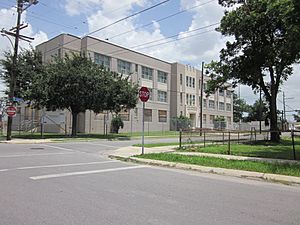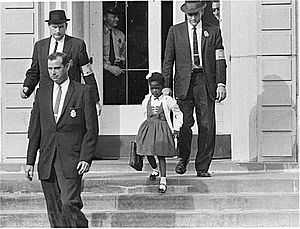Ruby Bridges facts for kids
Quick facts for kids
Ruby Bridges
|
|
|---|---|

Bridges speaking at Texas A&M University–Commerce in February 2015
|
|
| Born |
Ruby Nell Bridges
September 8, 1954 Tylertown, Mississippi, U.S.
|
| Occupation | Philanthropist, activist |
| Spouse(s) | Malcolm Hall |
| Children | 4 |
Ruby Bridges (born September 8, 1954) is an American civil rights activist. She is famous for being the first African American child to go to an all-white school in the South. This happened at William Frantz Elementary School in New Orleans, Louisiana, on November 14, 1960. Her brave story was shown in a famous 1964 painting by Norman Rockwell called The Problem We All Live With.
Contents
Ruby's Early Life
Ruby Nell Bridges was the oldest of five children. Her parents were Abon and Lucille Bridges. As a child, Ruby spent a lot of time helping to care for her younger brothers and sisters. She also loved playing jump rope, softball, and climbing trees.
When Ruby was four years old, her family moved from Tylertown, Mississippi, where she was born, to New Orleans, Louisiana. In 1960, when she was six, her parents agreed to a request from the National Association for the Advancement of Colored People (NAACP). They volunteered Ruby to help integrate the New Orleans school system. Her father was not sure at first, but her mother felt it was important.
The Fight for Equal Schools
Ruby Bridges was born during the time of the Civil Rights Movement. This was a period when many people worked to end unfair treatment of African Americans. A very important court decision, Brown v. Board of Education, happened just before Ruby was born in 1954.
This court ruling said that having separate public schools for white and black children was against the law. It meant that black students should be allowed to attend schools that were only for white students. Even though this decision was made in 1954, many Southern states did not want to follow it. They resisted integrating their schools. In 1957, soldiers were sent to Little Rock, Arkansas, to help nine black students attend an all-white school.
Under pressure from the government, the school board in New Orleans gave an entrance exam to students at Ruby's school. They hoped this test would keep black children out of white schools.
Integrating William Frantz Elementary
Ruby attended a separate kindergarten in 1959. In early 1960, Ruby was one of six black children in New Orleans who passed the special test. This test decided if they could go to the all-white William Frantz Elementary School. Two of the six children decided to stay at their old school. Ruby went to Frantz by herself. Three other girls (Gail Etienne, Leona Tate, and Tessie Prevost) went to another all-white school called McDonogh No. 19.
On their first day, all four six-year-old girls were walked to school by federal marshals. These marshals were like special police officers. They continued to escort the girls every day.
Ruby's father was worried at first. But her mother strongly believed that this step was needed. She wanted Ruby to get a better education. She also felt it was important "for all African-American children." Her mother finally convinced her father to let Ruby go to the school.
The first day of integrated schools in New Orleans was Monday, November 14, 1960. This day was captured in Norman Rockwell's famous painting, The Problem We All Live With. Ruby remembered seeing a large crowd outside the school. She thought it was like Mardi Gras because people were throwing things and shouting. A marshal named Charles Burks later said, "She showed a lot of courage. She never cried. She didn't whimper. She just marched along like a little soldier."
As soon as Ruby entered the school, white parents took their own children out. All the teachers, except for one, refused to teach while a black child was there. Only one person agreed to teach Ruby: Barbara Henry, from Boston, Massachusetts. For over a year, Mrs. Henry taught Ruby alone, as if she were teaching a whole class.
On that first day, Ruby and her mother spent the whole day in the principal's office. The school was too chaotic for them to go to a classroom. On the second day, a white student broke the boycott. A minister named Lloyd Anderson Foreman walked his five-year-old daughter, Pam, through the angry crowd. He said, "I simply want the privilege of taking my child to school…" A few days later, other white parents started bringing their children. The protests began to calm down. Still, Ruby remained the only child in her class until the next school year.
Every morning, as Ruby walked to school, some people would yell mean things. One woman threatened to poison her. Another held up a black baby doll in a coffin. Because of this, the U.S. Marshals only allowed Ruby to eat food she brought from home. She was also not allowed to play outside during recess.
A child psychiatrist named Robert Coles offered to help Ruby during her first year. He met with her every week at her home. Later, he wrote a children's book about her story called The Story of Ruby Bridges. Mr. Coles gave the money from his book sales to the Ruby Bridges Foundation. This foundation helps poor children in New Orleans get school supplies and other educational needs.
Ruby's family faced many challenges for sending her to William Frantz Elementary. Her father lost his job. The grocery store they used to shop at would no longer serve them. Her grandparents, who were farmers in Mississippi, were forced off their land.
But many people in the community, both black and white, supported the Bridges family. Some white families kept sending their children to Frantz despite the protests. A neighbor helped Ruby's father find a new job. Local people helped babysit Ruby, watched their house to protect it, and even walked behind the marshals' car on the way to school. Ruby later learned that the nice clothes she wore to school were sent to her family by a relative of Mr. Coles. Ruby said her family could never have afforded the dresses, socks, and shoes seen in photos of her with the U.S. Marshals.
Ruby's Adult Life
After finishing high school, Ruby Bridges worked as a travel agent for 15 years. Later, she became a full-time parent. Today, she leads the Ruby Bridges Foundation, which she started in 1999. This foundation teaches about "tolerance, respect, and appreciation of all differences." Ruby says about the group's goal, "racism is a grown-up disease and we must stop using our children to spread it."
Ruby's childhood story at William Frantz Elementary School was made into a TV movie in 1998 called Ruby Bridges.
In 2005, Ruby Bridges lost her home in New Orleans due to severe flooding from Hurricane Katrina. The hurricane also badly damaged William Frantz Elementary School. Ruby played a big part in fighting to keep the school open.
In November 2007, the Children's Museum of Indianapolis opened a new exhibit about Ruby's life. It is called "The Power of Children: Making a Difference."
In 2010, Ruby had a 50-year reunion at William Frantz Elementary with Pam Foreman Testroet. Pam was the first white child to break the boycott and attend the school with Ruby.
On July 15, 2011, Ruby Bridges met with President Barack Obama at the White House. They looked at the Norman Rockwell painting of her. President Obama told her, "I think it's fair to say that if it hadn't been for you guys, I might not be here and we wouldn't be looking at this together." The painting was shown in the West Wing of the White House from June to October 2011.
Ruby's Family Life
Ruby Bridges is married to Malcolm Hall. They have four sons.
Inspiring Words from Ruby Bridges
- "Don't follow the path. Go where there is no path and begin the trail. When you start a new trail equipped with courage, strength and conviction, the only thing that can stop you is you!"
- "I now know that experience comes to us for a purpose, and if we follow the guidance of the spirit within us, we will probably find that the purpose is a good one."
- "Racism is a grown-up disease and we must stop using our children to spread it."
Interesting Facts About Ruby Bridges
- Ruby enjoyed jumping rope, climbing trees, and playing softball when she was young.
- On November 14, her first day at William Frantz Elementary School, she was the only black student there.
- Barbara Henry was the only teacher who agreed to teach Ruby. She began teaching Ruby on her second day of school.
- Ruby's courageous story can be read to children from the book The Story of Ruby Bridges by Robert Coles.
- Ruby was one of only six children who passed the entrance test, which was designed to be difficult.
Awards and Honors for Ruby
Ruby Bridges has received many awards and honors for her bravery and work:
- In September 1995, she and Robert Coles received special degrees from Connecticut College.
- Her book, Through My Eyes, won the Carter G. Woodson Book Award in 2000.
- On August 10, 2000, she was made an Honorary Deputy U.S. Marshal.
- On January 8, 2001, President Bill Clinton gave her the Presidential Citizens Medal.
- In November 2006, she was honored as a "Hero Against Racism" at a concert in Washington, DC.
- On May 19, 2012, she received another special degree from Tulane University.
- On November 9, 2023, she received the Robert Coles Call of Service Award from Harvard University.
- On March 5, 2024, Ruby Bridges was added to the National Women's Hall of Fame. She was honored alongside tennis star Serena Williams.
Two elementary schools are named after Ruby Bridges: one in Alameda, California, and another in Woodinville, Washington. A statue of Ruby stands in the courtyard of William Frantz Elementary School. When asked what she hopes children will feel when seeing the statue, she said:
I think kids will look at it and think to themselves, 'I can do something great too.' Kids can do anything, and I want them to be able to see themselves in the statue. Hopefully that will remind [them that they] can change the world.
Images for kids
See also
 In Spanish: Ruby Bridges para niños
In Spanish: Ruby Bridges para niños





